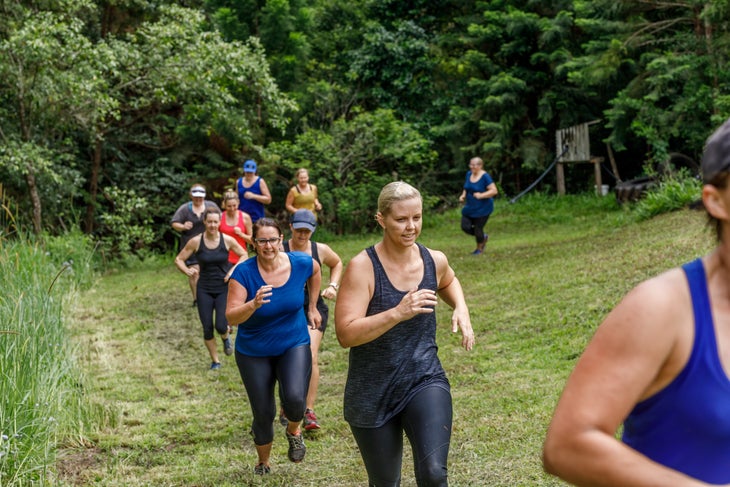New perk! Get after it with local recommendations just for you. Discover nearby events, routes out your door, and hidden gems when you sign up for the Local Running Drop.
Ultrarunning is an existential journey. What do we learn at mile 30 or 50 or 99? We learn that we are layers of self-aware meat and gristle built on stick-figure scaffolding. And every so often, when our muscles are mangled and every ounce of our physical being is telling us to stop, we catch a glimpse of something much greater. We find spiritual transcendence.
Ultrarunning is a journey to find the soul.
But it is important not to idealize ultrarunning. Big-name races like the Hardrock 100 or Ultra Trail du Mont Blanc (UTMB) certainly can be glorious. But actually pulling off an ultra—let alone a big, name-brand one—takes strategic planning, long-term thinking, and lots of training. Here are the principles you need to know to complete the journey, dial in your training plan, and run your first ultramarathon.
Before you do an ultra-specific long run, build an appropriate base
The biggest mistake I see in ultramarathon training is a failure to lay a sufficient foundation to handle the key long runs essential for ultra success. Before you open a restaurant, you should learn how to turn on the stove. The same logic applies to ultrarunning: run five or six times a week healthily, for a few months, before trying to lengthen long runs to over 16 miles. Failure to build a base of consistency results in injury and underperformance.
Focus on three to five key long runs, or back-to-back long-run weekends
An ultramarathon training cycle should look very similar to any other running training cycle. Most runs should be easy and not too long—between 30 and 90 minutes depending on your background. Then, after you have a base, start doing weekly long runs as you would for marathon training. Get comfortable consistently running between 16 and 20 miles once a week. Eight to 10 weeks out from your race, make that long run longer every second or third week.
For a 50K race, I have my athletes peak around 21 to 24 miles a few weeks before race day.
For a 50-mile or 100K race, I have athletes work up to a 50K about five weeks before race day. For advanced athletes, I add 25-mile and 20-mile back-to-back runs three weeks before race day.
For a 100-mile race, I suggest a 50-mile or 100K race about two months before race day, combined with a 50K effort a month out.
But remember: long runs are just the icing on the cake for ultramarathon training. First, make sure the cake is baked through, with consistent running, before getting your sugar high from running extra long.

Run downhills with purpose to make your legs bombproof
Uphills will always be difficult in ultras. Downhills are easy, until they become impossible.
When you run downhill, muscles in your legs undergo eccentric contractions that can cause micro-tears if you aren’t prepared. If you aren’t ready for those eccentric contractions, you’ll suddenly find yourself with “jello-legs” after a few tough downhills. That is why you can go easy the whole time but still find yourself unable to put one foot in front of the other in a race with lots of downhill.
I tell all my athletes to run all downhills with purpose during their long runs, running comfortably fast and learning to take off the brakes and flow. Downhill practice ensures that your legs aren’t ripped up on race day.
Races are won and lost on uphills, but finished and DNF’d on downhills. If you want to get to the finish line, don’t neglect downhill running.
Endurance without speed work is selling yourself short
Just because you will be going relatively slowly during the race doesn’t mean you shouldn’t go fast in training. One focused workout each week can make every pace feel easier—including paces that are a few minutes per mile slower. Among other things, speed workouts improve running economy, or the amount of effort it takes to run a given pace. Improve your economy, and paces that used to feel strained will begin to feel relaxed.
There is no magic workout, but there are magic guidelines: focus on running smooth, with total interval time of 10 to 40 minutes, broken up by recovery periods where you run easy. While there is an ideal way to build a plan for each individual, most middle-of-the-pack runners can benefit from doing whatever intervals they enjoy most, since fun breeds consistency.
Ultras require strength—think husky, not whippet
The longer you go, the more pounding the body takes. In general, stronger bodies are more prepared to weather the storm late in ultra races.
Just look at photos of runners descending a steep grade. You’ll see quads that are flexed to their max, hips that are sinking down with each footstrike and calves that are tense from absorbing the impact. Strong, resilient muscles are better equipped to handle those impact forces, rather than breaking down or transferring them to bones and tendons.
Do push-ups and light leg strength, eat plenty of food and don’t obsess about “race weight.” Strong goes the distance.

Most runners taper too much
There is no such thing as taper magic. You will not reach new levels of fitness after a few weeks of minimal running. If anything, overdone tapers will leave you feeling like a stale loaf of bread when you finally reach the start line.
Avoid crouton legs by training normally until about two weeks before the race. Then, cut down volume by 25 percent for a week, keeping intensity and a solid long run (most of my athletes do 16 miles the week before an ultra). In the final week, cut down volume a bit more, but be sure to keep running. If you need more taper than that, you are not training right to begin with.
When choosing gear, think about the end of the race, not the beginning
Ultras don’t start until the race is two-thirds complete. So for a 50-miler, the race starts at mile 33; for a 100-miler, it starts at 66. The variables that will make or break your experience are easier to control until that two-third mark. But after that, time and distance seem to take on new meaning. One minute becomes 10 minutes, and 10 miles becomes a marathon. Make decisions about gear based on that crucial time, not the relatively tame beginning stages of the race.
In practice, wear shoes that feel comfortable at the end of your long runs. Minimal shoes are often an exercise in masochism in the later stages of an ultra—err on the side of cushion for race day. Similarly, be sure your clothes are ready to go the distance. If you are running through the night, stay warm no matter what.
Fuel with a formula
Friends don’t let friends bonk. The body is a machine, which expends a certain amount of calories and fluids per hour. Once you know how the machine works, you can develop an owner’s manual specific to your needs that you know will work.
For most athletes, I recommend 16 to 24 ounces of fluid per hour (less for cold weather or people who don’t sweat that much, more for hot weather and heavy sweaters) and 200 to 300 calories per hour. Combining sports drink and gels is the best way to be sure you are staying on track. But no matter what, if you ever say, “I don’t want to eat at this point in the race—nothing sounds good,” remember that you will pay the price for failing to stick to a formula.
Practice positive psychology
We don’t run ultras because they are easy. We run them because they are hard. At some point in every race, all of the shish kabobs will hit the fan. Through smart training, you can push that crisis point back. But no matter how much you train, you’ll be left with a choice. Do I give up? Or do I laugh derisively in the face of failure?
That is a decision you make way before you get to the start line. During long runs, practice embracing the full-body fatigue. During hill intervals, think about the pain you are experiencing and take away the power it has over you. Most importantly, during your worst moments, remember to smile and laugh.
Ultras are a lot like life, condensed into a bite-sized morsel. It’s not about reaching the finish line first. It’s about learning to embrace the journey for its own sake.
David Roche partners with runners of all abilities through his coaching service, Some Work, All Play. With Megan Roche, M.D., he hosts the Some Work, All Play podcast on running (and other things), and they wrote a book called The Happy Runner.
